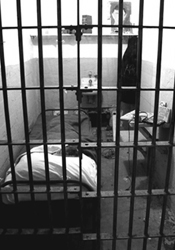San Francisco ponders a 2.9 million dollar court to penalize people for the act of being poor
 |
|
by Jennifer Fogg/POOR Magazine Race, Poverty and Media Justice Intern I fumble to take a seat, in the congested overflow room of San Francisco's City Hall. I focus on the commanding figure that fills the screen of the over sized television to my right. It is broadcasting the Board of Supervisor's hearing on Mayor Gavin Newsom's proposed Community Justice Center (CJC) from the packed room across the hall. The figure dominating the screen, I learn is Supervisor Ross Mirkarimi, from district 5. He is relaying his fears that the limited jurisdiction of the court, which ends near the border of his district, will cause what he called "crime creep" and that "serial inebriates" will slither over into the neighborhoods of his district if the court is put in place. The CJC will handle non-violent, misdemeanor and felony cases, so called quality of life crimes, such as loitering and graffiti among many others. Instead of being issued a citation, people will be taken directly into the CJC and given a community service sentence, always with the threat of incarceration behind it. The court will have jurisdiction over parts of SOMA, Civic Center, Union Square, and the Tenderloin. According to the Mayor's Office of Criminal Justice, a primary goal of the court is to, "serve as a gateway to social services through the power of the court." Newsom's CJC project is based on former Mayor Giuliani's Midtown Community Court in Manhattan, which by all corporate media accounts has been a shining example of how to eliminate the visible signs of poverty and create a Disneyesque Times Square. The Mayor has proposed to cut $20 million from existing social programs in his new budget, leaving the most vulnerable of San Francisco's citizens to bear the brunt of the burden. Simultaneously proposing the CJC, which is supposed to be a "gateway" to these very services, will cost an estimated 2.9 million dollars just to implement. The two seem incompatible. It appears that Mayor Newsom would like to follow Giuliani's lead, and cut the poor out of the fabric of San Francisco. Supervisor Chris Daly likened the CJC to a "social experiment". From the glowing screen in the overflow room, a line of people stretching the length of the Board of Supervisors chambers, waited to have their voices heard on this issue. One of the most powerful speakers came from the voice of one of the co-founders and executive director of POOR magazine, Tiny aka Lisa Gray-Garcia, who articulated that, "the proposed court is another manifestation of the criminalization of poverty and poor people of color that was tried out in New York under Giuliani as a way to penalize people for the sole act of being poor. No matter how many times you put people in jail for being poor it won't change their poverty. As well, this is the way that the criminal industrial complex can begin to systematically feed poverty criminals, like myself into its hungry jaws". By the close of the hearing the Supervisors voted No on releasing the funds to initiate the CJC, but this didn't sit well with the Mayor. On June 17th he filed a measure with the Board of Elections to put his Community Justice Center initiative on the ballot in November. As I collect my notes and pen I can only hope that the voters of San Francisco will think long and hard about the implications a court like Newsom's Community Justice Center will have on our city. While phrases like "social experiment" and "crime creep" clamor in my head these questions form on my lips: what does it say about our compassion, our tolerance, our very humanness if we choose to deem people criminals because they may occasionally annoy us, or make us uncomfortable, or may not have any where else to go? Will this kind of court do anything to address the systemic causes of these so called crimes, such as the lack of affordable housing, unattainable healthcare, racism, or our dwindling civil liberties, or is it another progression of these very problems? |



